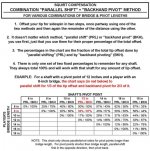"Backhand" and "parallel" english are two popular ways to compensate for squirt. "Backhand" is moving the backhand to apply sidespin, pivoting the cue at the bridge (which may be adjusted for the purpose). "Parallel" is (supposedly) shifting the stick sideways and parallel to apply sidespin (I say "supposedly" because truly parallel wouldn't work).
Backhand is the "automatic" method, but it only works well when your bridge is positioned very near your cue's pivot point.
There's an app for that. Well, actually it's a simple system that compares your bridge length and your shaft's pivot length to find the ratio of "parallel shift" and "backhand pivot" methods that will accurately correct your shaft for squirt. When the two methods are combined in the right amounts they automatically place the tip at the desired sidespin offset and the cue's pivot point on the CueBall/GhostBall centerline - so anybody, no matter how close or far their pivot point is from their bridge, can use this "mechanical" squirt compensation method based on backhand english.
This chart shows the ratios of both methods to use for any tip offset given various bridge/pivot lengths.

pj
chgo
Backhand is the "automatic" method, but it only works well when your bridge is positioned very near your cue's pivot point.
There's an app for that. Well, actually it's a simple system that compares your bridge length and your shaft's pivot length to find the ratio of "parallel shift" and "backhand pivot" methods that will accurately correct your shaft for squirt. When the two methods are combined in the right amounts they automatically place the tip at the desired sidespin offset and the cue's pivot point on the CueBall/GhostBall centerline - so anybody, no matter how close or far their pivot point is from their bridge, can use this "mechanical" squirt compensation method based on backhand english.
This chart shows the ratios of both methods to use for any tip offset given various bridge/pivot lengths.

pj
chgo
Last edited: